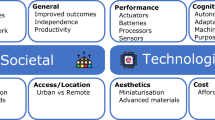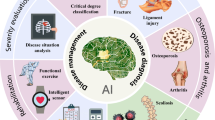Abstract
Recent advances in optical and robotic technologies have given surgeons high-definition eyes and precision hands that perform beyond human capabilities. This has expanded the scope of minimally invasive surgery and increased opportunities for surgery in high-risk situations; however, absolute surgical safety has not yet been achieved. Deficiencies in human performance are associated with surgical adverse events and advanced surgery places stress on surgeons and affect their concentration, causing not only novice surgeons with limited experience, but even skilled surgeons, to make misrecognition and decision-making errors. Therefore, the issue of “surgical comfort” for surgeons cannot be ignored. In recent years, artificial intelligence (AI), which is designed to mimic the function of the human brain, has been developed in various fields to assist humans. Computer vision, a visual assistive technology that uses AI, is being applied to surgery and will become available in the near future. AI-controlled robots cannot be expected to replace surgeons, because surgeons operate with higher brain functions that integrate all their abilities, including the senses of humanity, mission, and ethics. However, if there is a way to reduce the mental and physical burden on surgeons by utilizing AI technology, then it should not be ruled out.


Similar content being viewed by others
References
The American Society of Mechanical Engineers. Infographic: defining the 6 levels of self-driving autonomy. 2021. https://www.asme.org/topics-resources/content/infographic-defining-the-6-levels-of-self-driving-autonomy. Accessed 15 Aug 2022
Subaru. Survey reveals Subaru vehicles equipped with EyeSight had 60% fewer accidents in Japan (in Japanese). https://www.subaru.jp/safety/eyesight/. Accessed 15 Aug 2022
Ministry of Land, Infrastructure, Transport and Tourism. Current situation and issues concerning crew members, etc. in Japan (in Japanese). 2013. https://www.mlit.go.jp/common/001019364.pdf. Accessed 15 Aug 2022
PlaneCrashInfo.com. Home page. http://www.planecrashinfo.com/index.html. Accessed 15 Aug 2022
Shinohara H, Kurahashi Y, Ishida Y. Gastric equivalent of the ‘Holy Plane’ to standardize the surgical concept of stomach cancer to mesogastric excision: updating Jamieson and Dobson’s historic schema. Gastric Cancer. 2021;24:273–82.
Japanese Gastric Cancer Association. Japanese gastric cancer treatment guidelines 2018 (5th edition). Gastric Cancer. 2021;24(1):1–21.
Hohenberger W, Weber K, Matzel K, Papadopoulos T, Merkel S. Standardized surgery for colonic cancer: complete mesocolic excision and central ligation–technical notes and outcome. Colorectal Dis. 2009;11:354–64.
Heald RJ. The ‘Holy Plane’ of rectal surgery. J R Soc Med. 1988;81:503–8.
Sasako M, Sano T, Yamamoto S, Kurokawa Y, Nashimoto A, Kurita A, et al. D2 lymphadenectomy alone or with para-aortic nodal dissection for gastric cancer. N Engl J Med. 2008;359:453–62.
Sano T, Sasako M, Mizusawa J, Yamamoto S, Katai H, Yoshikawa T, et al. Randomized controlled trial to evaluate splenectomy in total gastrectomy for proximal gastric carcinoma. Ann Surg. 2017;265:277–83.
Kurokawa Y, Doki Y, Mizusawa J, Terashima M, Katai H, Yoshikawa T, et al. Bursectomy versus omentectomy alone for resectable gastric cancer (JCOG1001): a phase 3, open-label, randomised controlled trial. Lancet Gastroenterol Hepatol. 2018;3:460–8.
Kitano S, Inomata M, Mizusawa J, Katayama H, Watanabe M, Yamamoto S, et al. Survival outcomes following laparoscopic versus open D3 dissection for stage II or III colon cancer (JCOG0404): a phase 3, randomised controlled trial. Lancet Gastroenterol Hepatol. 2017;2:261–8.
Marubashi S, Takahashi A, Kakeji Y, Hasegawa H, Ueno H, Eguchi S, et al. Surgical outcomes in gastroenterological surgery in Japan: report of the national clinical database 2011–2019. Ann Gastroenterol Surg. 2021;5:639–58.
Uyama I, Suda K, Nakauchi M, Kinoshita T, Noshiro H, Takiguchi S, et al. Clinical advantages of robotic gastrectomy for clinical stage I/II gastric cancer: a multi-institutional prospective single-arm study. Gastric Cancer. 2019;22:377–85.
Suliburk JW, Buck QM, Pirko CJ, Massarweh NN, Barshes NR, Singh H, et al. Analysis of human performance deficiencies associated with surgical adverse events. JAMA Netw Open. 2019;2: e198067.
Boeing. Statistical summary of commercial jet airplane accidents, 1959–2008. 2009. https://skybrary.aero/sites/default/files/bookshelf/2716.pdf. Accessed 15 Jun 2022
Yang GZ, Cambias J, Cleary K, Daimler E, Drake J, Dupont PE, et al. Medical robotics-Regulatory, ethical, and legal considerations for increasing levels of autonomy. Sci Robot. 2017. https://doi.org/10.1126/scirobotics.aam8638.
Rajpurkar P, Irvin J, Ball RL, Zhu K, Yang B, Mehta H, et al. Deep learning for chest radiograph diagnosis: a retrospective comparison of the CheXNeXt algorithm to practicing radiologists. PLoS Med. 2018;15: e1002686.
Bejnordi BE, Veta M, van Diest PJ, van Ginneken B, Karssemeijer N, Litjens G, et al. Diagnostic assessment of deep learning algorithms for detection of lymph node metastases in women with breast Cancer. JAMA. 2017;318:2199–210.
Hashimoto DA, Rosman G, Rus D, Meireles OR. Artificial intelligence in surgery: promises and perils. Ann Surg. 2018;268:70–6.
Hashimoto DA, Rosman G, Witkowski ER, Stafford C, Navarette-Welton AJ, Rattner DW, et al. Computer vision analysis of intraoperative video: automated recognition of operative steps in laparoscopic sleeve gastrectomy. Ann Surg. 2019;270:414–21.
Kitaguchi D, Takeshita N, Matsuzaki H, Oda T, Watanabe M, Mori K, et al. Automated laparoscopic colorectal surgery workflow recognition using artificial intelligence: experimental research. Int J Surg. 2020;79:88–94.
Luongo F, Hakim R, Nguyen JH, Anandkumar A, Hung AJ. Deep learning-based computer vision to recognize and classify suturing gestures in robot-assisted surgery. Surgery. 2021;169:1240–4.
Bodenstedt S, Wagner M, Mündermann L, Kenngott H, Müller-Stich B, Breucha M, et al. Prediction of laparoscopic procedure duration using unlabeled, multimodal sensor data. Int J Comput Assist Radiol Surg. 2019;14:1089–95.
Jermyn M, Desroches J, Mercier J, Tremblay MA, St-Arnaud K, Guiot MC, et al. Neural networks improve brain cancer detection with Raman spectroscopy in the presence of operating room light artifacts. J Biomed Optic. 2016;21: 094002.
Tokuyasu T, Iwashita Y, Matsunobu Y, Kamiyama T, Ishikake M, Sakaguchi S, et al. Development of an artificial intelligence system using deep learning to indicate anatomical landmarks during laparoscopic cholecystectomy. Surg Endosc. 2020;35:1651–8.
Yamazaki Y, Kanaji S, Matsuda T, Oshikiri T, Nakamura T, Suzuki S, et al. Automated surgical instrument detection from laparoscopic gastrectomy video images using an open source convolutional neural network platform. J Am Coll Surg. 2020;230:725-32.e1.
Madani A, Namazi B, Altieri M, Hashimoto DA, Rivera MA, Pucher PH, et al. Artificial intelligence for intraoperative guidance: using semantic segmentation to identify surgical anatomy during laparoscopic cholecystectomy. Ann Surg. 2020. https://doi.org/10.1097/SLA.0000000000004594.
Mascagni P, Vardazaryan A, Alapatt D, Urade T, Emre T, Fiorillo C, et al. Artificial intelligence for surgical safety: automatic assessment of the critical view of safety in laparoscopic cholecystectomy using deep learning. Ann Surg. 2020. https://doi.org/10.1097/SLA.0000000000004351.
Mascagni P, Alapatt D, Urabe T, Vardazaryan A, Mutter D, Marescaux J, et al. A computer vision platform to automatically locate critical events in surgical videos: documenting safety in laparoscopic cholecystectomy. Ann Surg. 2021;274:e93–5.
Shinohara H, Kurahashi Y, Haruta S, Ishida Y, Sasako M. Universalization of the operative strategy by systematic mesogastric excision for stomach cancer with that for total mesorectal excision and complete mesocolic excision colorectal counterparts. Ann Gastroenterol Surg. 2017;2:28–36.
Kumazu Y, Kobayashi N, Kitamura N, Rayan E, Neculoiu P, Misumi T, et al. Automated segmentation by deep learning of loose connective tissue fibers to define safe dissection planes in robot-assisted gastrectomy. Sci Rep. 2021;11:21198.
Sartorius - cell instance segmentation: detect single neuronal cells in microscopy images. https://www.kaggle.com/competitions/sartorius-cell-instance-segmentation/overview. Accessed 15 Aug 2022
Anaut. https://anaut-surg.com. Accessed 15 Aug 2022
Mirnezami R, Ahmed A. Surgery 3.0, artificial intelligence and the next-generation surgeon. Br J Surg. 2018;105:463–5.
Acknowledgements
This work was supported in part by the Japan Society for the Promotion of Science (KAKENHI Grant Number 22H03153).
Author information
Authors and Affiliations
Corresponding author
Ethics declarations
Conflict of interest
The author declares that there is no conflict of interest.
Additional information
Publisher's Note
Springer Nature remains neutral with regard to jurisdictional claims in published maps and institutional affiliations.
Rights and permissions
Springer Nature or its licensor holds exclusive rights to this article under a publishing agreement with the author(s) or other rightsholder(s); author self-archiving of the accepted manuscript version of this article is solely governed by the terms of such publishing agreement and applicable law.
About this article
Cite this article
Shinohara, H. Surgery utilizing artificial intelligence technology: why we should not rule it out. Surg Today 53, 1219–1224 (2023). https://doi.org/10.1007/s00595-022-02601-9
Received:
Accepted:
Published:
Issue Date:
DOI: https://doi.org/10.1007/s00595-022-02601-9




